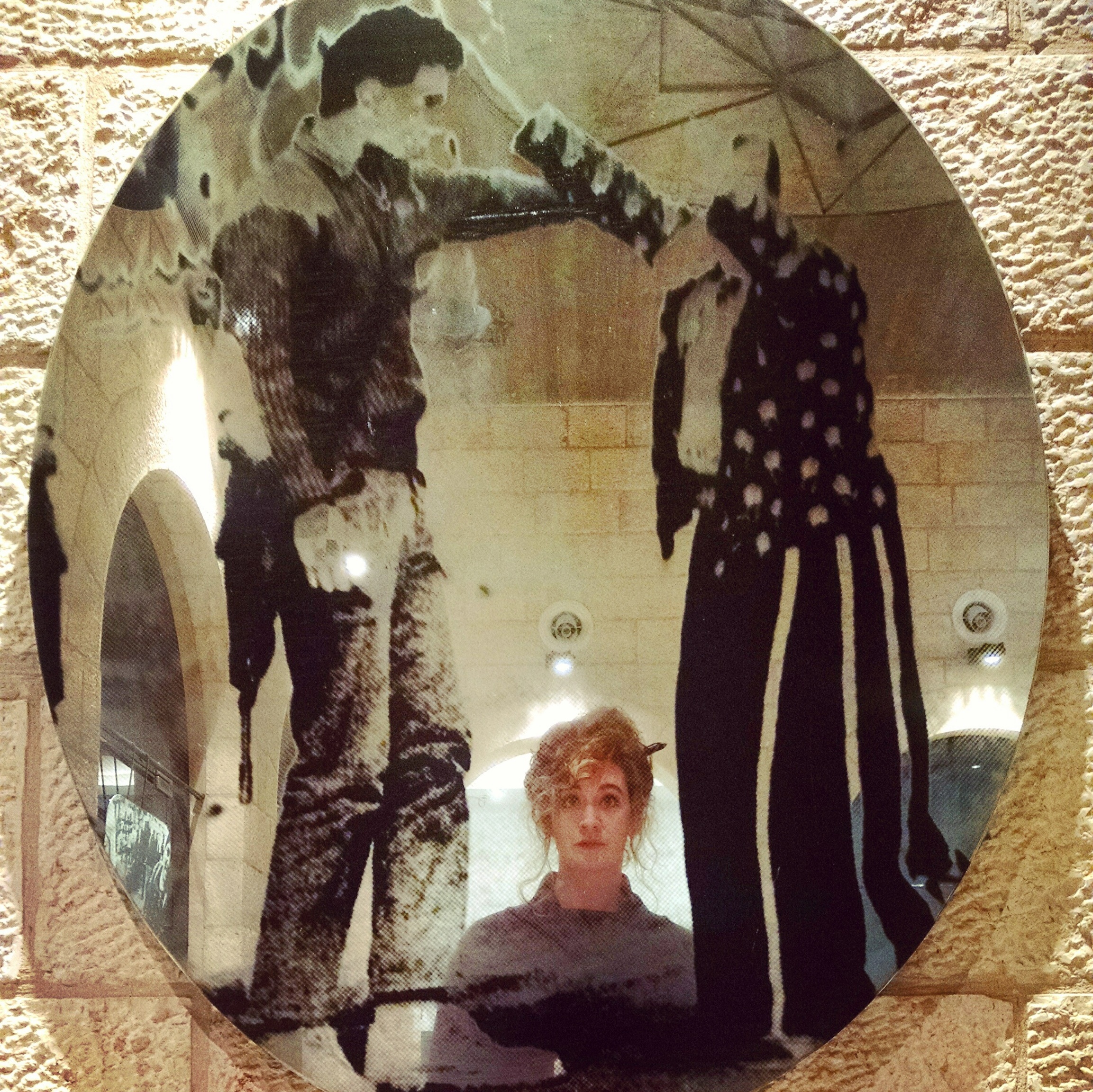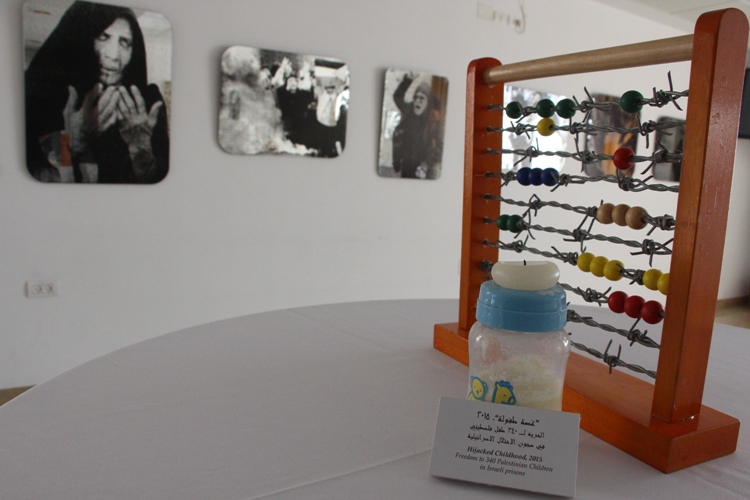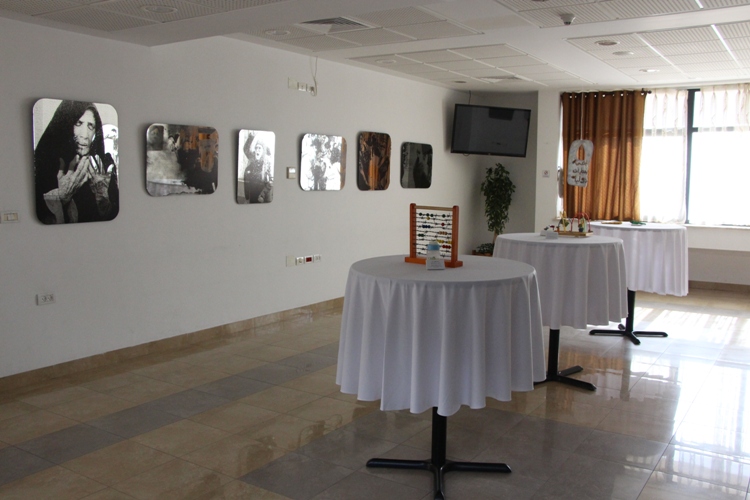
“Reflecting Our Current Reality – Palestine Depicted in Art”

“Reflecting Our Current Reality – Palestine Depicted in Art”
Can you recall your favorite childhood toy or activity? Perhaps you can remember the carefree nature of running around with your friends and playing games in the yard. For a large number of Palestinian children, this is not their reality. Many of these moments of normalcy are crushed by violence like night-raids, tear-gas, harassment and even arrests and detainment. These children grow up under the weight of the Israeli occupation, and their development is greatly effected by this ongoing violence.
Hoping to shed light on this harsh reality, local artist, Rana Bishara, has artistically taken everyday items and conveyed them in such a way that portrays the current plight of children in Palestine. In tandem with her pieces that depict the challenges that children in Palestine face, she has also championed the role of women in Palestinian society as they engage with the struggle for freedom.
Rana describes her work by stating, “It is my duty as an artist, as a human being, as a Palestinian, and as a woman to deliver this message in the most civilized way – the most eloquent way – so that it is heard and able to be delivered in a very good form.”
“Stolen Childhood”
On display, Rana shows several different types of toys or items that are representative of a child’s upbringing. An abacus, whose strings are made of barbed wire, represents the inhibited ability to learn under occupation. In the same line of thought, a chalkboard with tally marks shows that instead of studying and learning properly, children are counting their days spent in prison.
In her piece, “Deflated Childhood,” balloons pierced with small pins lie on top of one another. Rana describes that which used to be used for celebrations now symbolizes the deflated dreams of these children.
A birthday cake decorated for Ahmad Manasra is frosted with barbed wire and cactus as a stinging reminder that this 13-year-old child will be celebrating his 14th birthday in an Israeli prison.
Among many other pieces, Rana has masterfully combined the many scenarios that children in Palestine face with a creative expression that prompts the viewer to engage with their own memories of childhood. By reintroducing the human component of how conflict and occupation affect the lives of the most vulnerable, Rana goes one step further in her exhibit portraying women.
“Reflecting Reality”
Hanging on the walls around her work devoted to the children are around ten mirrors. On each mirror, roughly half a meter in width and height, is printed a scene of the women’s struggle in Palestine. Images from the first and second Intifada along with many others depict the women in their society engaging in resistance and advocating freedom. Some women are caring for those that have been injured in the fighting, some are covering their faces as they weep, and yet others are standing in confrontation with Israeli soldiers. As people pass through the mirror exhibit looking to each scene, they are forced to also see themselves in this image. The mirror reflects their image into the scene provoking a response from the viewer. Rana stated, “I want the person to establish a dialogue between himself and the image, and see himself in this image of resistance and dignity.”
“Returning Us to Ourselves”
As I walked through Rana’s exhibit, I couldn’t help but think to myself that we’ve forgotten how violence and conflict affect every aspect of society. So often the ongoing situation in Israel and Palestine becomes a fleeting news line, and keeping up becomes difficult. Many of the stories begin to sound the same, and perhaps in an effort to maintain a level of operational function, we don’t internalize what we are seeing, reading or even experiencing. Rana’s artwork provokes you to go beyond that kind of preservation. Staring at myself in a mirror depicting an elderly woman with her hands raised while an armed soldier stands in front of her draws me into the scene. For each person looking into one of these mirrors, a different response can be expected. At the core, however, the hope is to humanize the people that are experiencing these atrocities that are happening to everyday people like you and I. Perhaps it is in these moments that we begin to realize the destruction and demoralization that we subject one another to, and how by doing it to one we really do it to us all. Rana stated it this way, “When a child is detained, the whole family is detained; and when the whole family is detained, the whole nation is detained. “
Perhaps it is high time for us to release ourselves from the “us” and “them” mentalities and begin to see humanity as something we are all uniquely a part of.
If you are local and interested in seeing Rana’s exhibit for yourself, stop by and see her artwork! It will be on display in the Bishara Awad Center at Bethlehem Bible College until December 8, 2016.
Kamila is volunteering full-time with Bethlehem Bible College in the Communications Department. In addition to her love for writing and sharing stories, her endeavors in Bethlehem and greater Palestine involve facilitating cultural immersion programs for young adults from North America to see first-hand the realities that those living here encounter. At times deemed the “eternal optimist,” Kamila holds fast to the future hope of restoration and reconciliation of all things back to God. When she’s not writing, or organizing trips, you’ll catch her training and competing with the Ultimate Palestine frisbee team.




